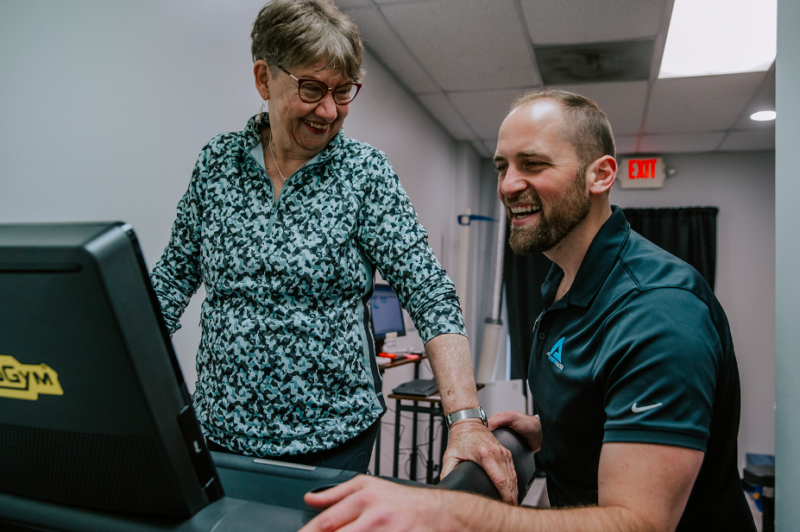You’ve probably heard a lot about High Intensity Interval Training (or HIIT). You’ve also probably heard of Zone 2 Cardio. Some of the claims around HIIT might even make it seem like an obvious choice to improve your health, fitness and body composition. However, there is increasing interest in Zone 2 Cardio and its unique benefits. Let’s explore both Zone 2 Cardio and HIIT to see which one is right for you.
What is HIIT?
If you’re looking for a deeper dive into HIIT check out this blog I wrote: The Truth Behind HIIT and if it’s Right for You. For the purpose of this comparison article, I’ll give a high-level explanation of HIIT and then we’ll compare and contrast HIIT and Zone 2 Cardio.
HIIT is characterized by periods of high intensity exercise interspersed with periods of lower intensity exercise. Examples could include:
- Running for 1 minute, walking for 1 minute, repeating that combination 10 times
- Cycling hard for 90 seconds, Cycling easy for 30 seconds, repeating that combination 15 times
- Doing squats for 45 seconds, bicep curls for 45 seconds, resting for 45 seconds (this commonly referred as HIIT Circuit Training)
The basic formula is:
- Exercise hard for a specific period of time (normally 30 seconds to 5 minutes)
- Exercise easy or passively recover (normally for 30 seconds to 2 minutes)
- Repeat that combination 5-15 times
You can use any form of exercise for HIIT if you follow that formula. Typically it’s performed with a traditional aerobic exercise (like running/jogging, cycling, rowing, or an elliptical trainer). As I noted above, it can also be performed by using body weight-based calisthenic exercises or using small apparatus equipment (light dumbbells, medicine balls, and bands). When this is done it is called HIIT Circuit Training.

What is Zone 2 Cardio?
This one is a little easier to explain and it’s something that most of us are familiar with. This is selecting one of the traditional aerobic exercise types mentioned previously and performing it at a relatively consistent intensity for a set amount of time. Examples include:
- Walking for 30 minutes at 60-70% of your maximum heart rate
- Cycling for 45 minutes at a Rate of Perceived Exertion of 6-7 on a scale of 10
- Using an Elliptical Trainer for 60 minutes being able to pass the talk test
When you think of someone performing “cardio” in a gym, this is the picture that comes to mind.
HIIT vs. Zone 2 Cardio
The biggest difference between the two approaches to exercise really has to do with intensity. HIIT, as the name suggests, is done at a much higher intensity than Zone 2 Cardio. If Zone 2 Cardio is done at a 6-7 on a scale of 10, HIIT is done at a 9-10 out of 10. Another way of looking at this is Zone 2 Cardio is done at 60-70% of your max heart rate, and HIIT is done at > 90% of your max heart rate. Because HIIT is done at a higher intensity it can be done for a shorter amount of time. That’s a general rule of exercise, the harder you go, the less time you have to go to derive the same benefit.
The other primary difference is that you can’t really do Zone 2 Cardio circuit training, it just doesn’t work. If you’re looking to get benefit of circuit training, in some fashion or another, it needs to be HIIT by its nature.

What’s Better HIIT or Zone 2 Cardio?
Let me start practically here and then I’ll move to the science. Without a doubt the best form of exercise for you to perform is the one you’ll enjoy and do consistently. Sometimes we can get caught up in “research findings” and forget how enjoyment drives performance. There is no form of exercise that is effective if it’s not performed. Conversely, nearly any exercise, when performed consistently, can be incredibly effective.
Don’t sleep on this point. In my 20+ year career as an exercise physiologist many people have asked me about the optimal exercise program. My response is always that I don’t care about optimal, I care about probable – more specifically the exercise program you will probably stick to!
With that as a backdrop, let me distill down the research in a couple of key points. First and foremost, both types of exercise produce similar results with regard to cardiovascular fitness and general health when they’re performed consistently. Keep in mind that the higher your intensity the shorter you have to exercise for, the lower your intensity the longer you have to exercise for to get the same benefit.
HIIT does allow for the performance of circuit training, which is great if you’re trying to get muscular fitness and aerobic benefits out of the same workout. Lastly, HIIT when performed properly may result in greater Excess Post-Exercise Oxygen Consumption (EPOC of the “after burn”), this can result in greater levels of fat burning at rest after the exercise bout. Please don’t take that point to mean you’ll actually lose more fat if you do HIIT. That only happens if you’re in a sufficient calorie deficit.
Reading all of that, you might think that HIIT is the clear winner, but not so fast. I’ll again make reference to this article: The Truth Behind HIIT and if it’s Right for You. As I note in that piece HIIT is not appropriate for beginner exercisers. In fact, not only is it not appropriate, it could result in injury or loss of motivation due to the high levels of exertion that the body and the mind aren’t prepared for. At the end of that article, I recommend a great starting point for a beginner, start there and decide if you want to progress to HIIT.
If you’re not a beginner, HIIT might be worth giving a try for some of the reasons I mentioned above. Just keep in mind what I said to start this last section of the article off – find the type of exercise you enjoy the most, that will be the best exercise for you!
Not Sure Where to Start?
At Applied Fitness Solutions, we know it can be difficult and confusing to go it alone on your journey to take back control of your health. To learn more about how we structure our HIIT program, view our Fitness Solutions Class page that explains it all.
